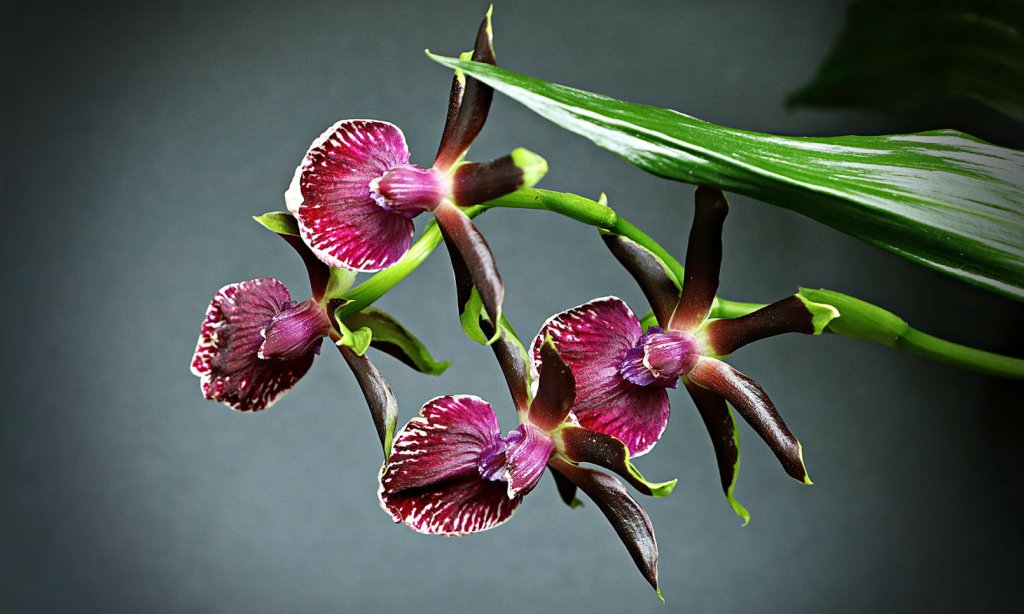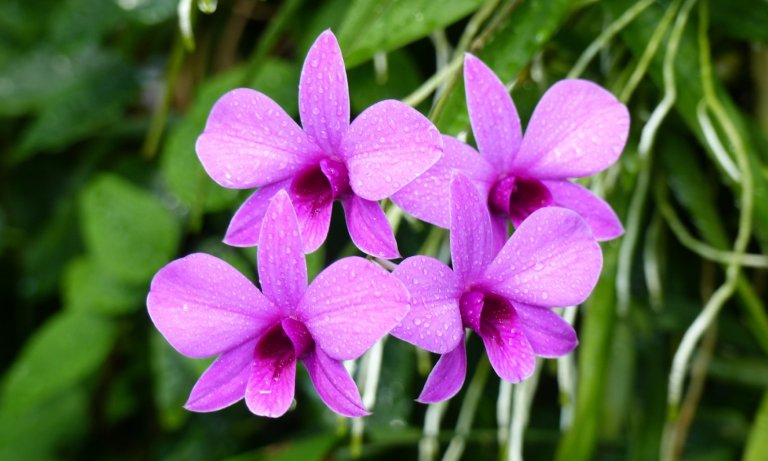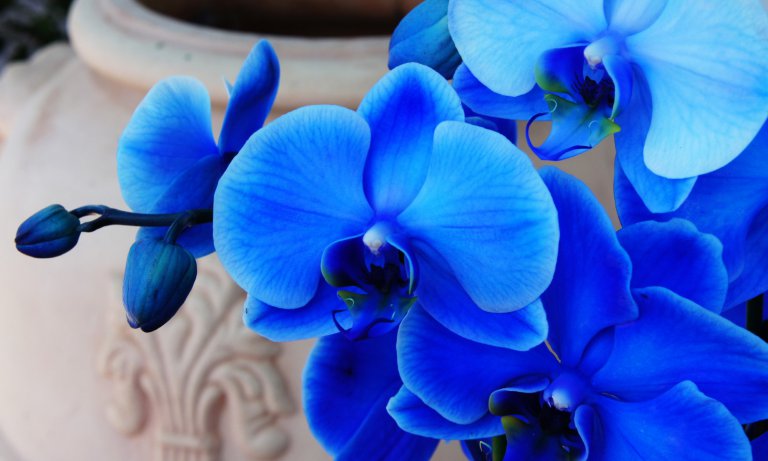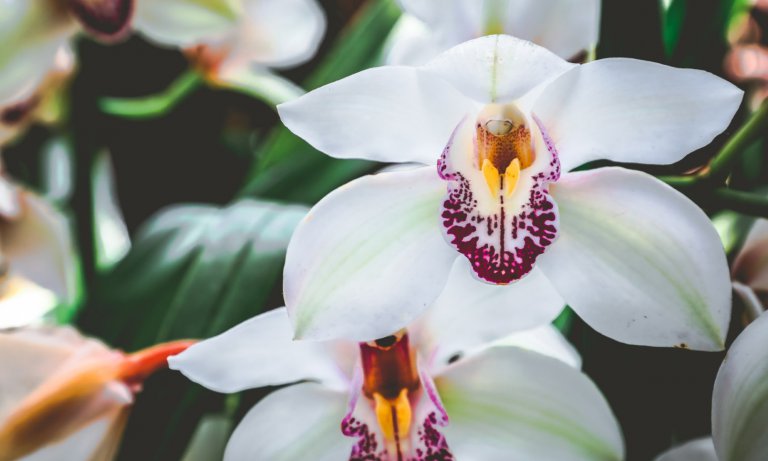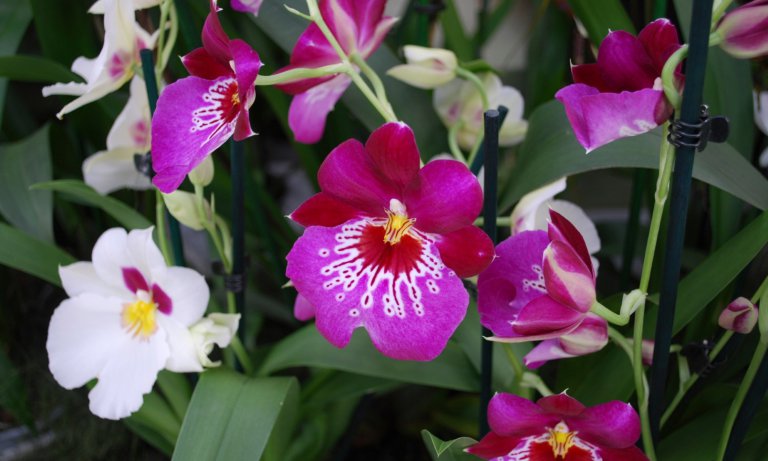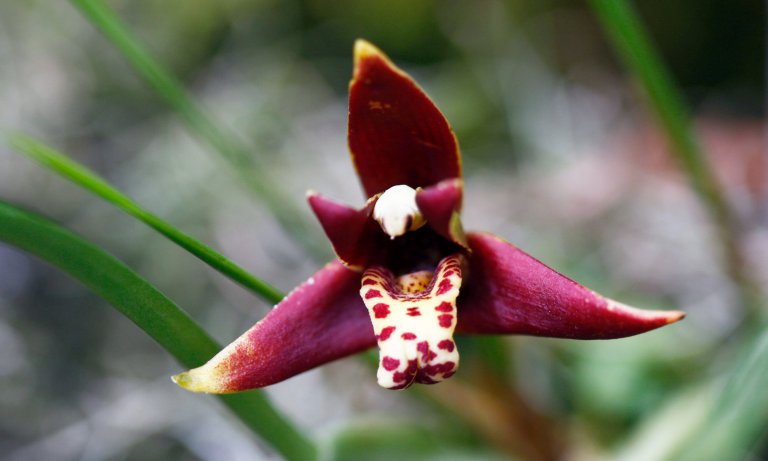Zygopetalum orchids are rewarding plants, known for their ease of culture, and deep-colored, fragrant blooms. Their flowers are long-lasting, making them great plants to add some color to your home, but this also puts them in high demand as cut flowers.
There are only fourteen species in the Zygopetalum genus, and hybrid species are highly sought after by orchid enthusiasts. The most commonly grown species of this genus are Z. Intermedium, Z. Mackayi, and Z. Maxillare. Both the pure species and most hybrids are relatively easy to grow, making them great plants for beginners.
Natural Habitat
Zygopetalums are native to the mid-elevation areas of South America. They mostly grow inside rainforests and are therefore used to a humid environment. Some species, like Zygopetalum Maculatum and Zygopetalum Intermedium, grow mainly in the mountains.
These plants are epiphytic, which means they grow on tree trunks. Therefore they cannot tolerate soggy potting mixes. There are also some terrestrial species, like Zygopetalum Triste. You should find out the exact species of your plant so you can provide the appropriate care.
How to Care for Zygopetalum Orchids
Now that we know about their natural habitat, we can look to recreate this at home.
Light
The light requirements for Zygopetalums are between those of Phalaenopsis and Oncidium orchids. Zygos like bright light. The ideal level is circa 3,000 foot-candles. A happy Zygo will have light green leaves and often a slight yellow tint. On the flip side, the leaves will be dark green if the plant is lacking light.
A great place to place your Zygopetalum orchid is a south-facing windowsill, where they can rest in a bright shade. Shade is important for Zygos, as they naturally grow in the rainforest and are often shielded from direct sun while they grow on tree trunks.
Direct sunlight throughout the day will most likely harm your plant. Keep an eye on the color of the leaves. They will become yellow if the plant is receiving too much light.
Related: How Much Light Do Orchids Need?
Temperature
Zygopetalum orchids grow well in moderate temperatures. The optimal day temperature is between 70F and 75F, and it should be about 10F lower during the night.
However, you should always check what particular species you have. Those that grow at higher altitudes, such as Zygopetalum Maculatum and Zygopetalum Intermedium, prefer cooler temperatures.
Zygo orchids are quite tough plants and may withstand higher temperatures during summer if you water them frequently. Similarly, during winter, they can survive temperatures lower than 50F if you keep them drier than usual.
A bad combination is to keep Zygos in a cold and moist environment. This is often the cause of small spots on the leaves, which are a common problem for this type of orchid.
Humidity
Zygopetalums’ natural habitat is the rainforest. They are therefore used to humid conditions and plenty of rainfalls. Humidity is particularly important during the growing season when the new pseudobulbs are being formed.
The optimal humidity level is around 60%-70%, and up to 80% in summer. However, these plants are tough, and they can grow well in low humidity if everything else is appropriate.
If humidity levels are quite high, you should have proper ventilation to avoid the risk of fungal or bacterial infection for your Zygopetalum orchid. Zygos are also very susceptible to rotting when the air is stagnant. Therefore good air movement is essential for these plants.
Watering

Zygopetalums need plenty of water while they are growing. However, you should evaluate the requirement of the particular species you have. Note that unlike some other orchids, Zygo orchids do not go on a fully dormant phase during winter.
These orchids often experience unusual rainfall patterns in their native environment. Winter and fall are usually wet in the rainforest, and spring and summer are even wetter. As a result, you should water them every two days during the warmer months. You can limit watering to around once a week once the growing phase has finished. This is usually in fall when the water-storing pseudobulbs have fully formed.
You should not leave the mix to completely dry as these plants do not experience any dry period in their natural habitat.
When watering your Zygopetalum orchid, avoid getting the pseudobulbs wet. As the pseudobulbs are very close to each other, the space between them is poorly aerated, and stagnant water may cause rotting and fungal infections.
Zygopetalum orchids and their hybrids tend to be sensitive to mineral build-up. You should use rainfall, distilled water, or reverse osmosis.
Related: How to Water an Orchid
Potting Mix
The potting mix will depend on the specific orchid species. Some Zygopetalums are epiphytic, whereas other species are terrestrial. In general, Zygopetalum orchids are tolerant of the potting mix as long as it’s airy and has excellent drainage.
Epiphytic Zygopetalums grow well in a combination of bark, perlite, and small quantities of sphagnum moss. Some charcoal at the bottom of the pot may be beneficial if you’re using tap water in an area with hard water. Scoria or Aliflor are not particularly good mixes for Zygos.
A particular mixing component that may be beneficial is dolomitic lime (calcium magnesium carbonate). You can add some on top of the mix twice a year, and the result will be stronger leaves that are less likely to bruise.
Related: Orchid Potting Mix
Pot
Zygopetalums are not very pot-bound. When choosing a pot, leave a margin of free space (around one inch) at the sides of the container. Most species, including Z.intermedium, Z.mackayi, Z.crinitum, and Z.maxillare, prefer shallow pots.
Related: Best Orchid Pots: Beginner’s Buying Guide
Repotting
A six to eight-inch pot is good for the first years of a Zygo orchid, as they tend to cluster their pseudobulbs close to each other. Remember that these plants are not very pot-bound, so once you notice that the pot is becoming a little small and the roots are being squashed, it may be time for repotting.
Usually repotting is done every two to three years, or when you notice that the orchid is not growing well. It may be the case that salts have accumulated at the roots, and the plant cannot absorb useful minerals.
Most of the new growths are produced during spring and summer. You should time the repotting to coincide with the end of the plant’s blooming cycle.
Zygos are quite succulent, and you should use great care when repotting them, so as not to damage the pseudobulbs.
Related: How to Repot an Orchid: Step by Step Guide
Blooms

Zygopetalum orchids are very rewarding. They generally bloom twice a year. However, some species can bloom up to four times a year! Their flowers last up to a month. It is indeed lovely to have a plant in full bloom in winter when most other plants have finished their blooming cycle.
The inflorescences tend to be longer than the leaves, and they have up to seven flowers. Five flowers in a spike are often considered to be a sign of good health. Another bonus of growing a Zygopetalum orchid is that its flowers are usually very fragrant.
The primary flower shades are purple, burgundy, and green. Some Zygopetalum species can even have blue flowers, and blue is a highly sought-after color in orchids. Flowers can be spotted and have several patterns, and the diameter is around two to three inches.
If your Zygopetalum is struggling to flower, you should move it to a place with plenty of light. The difference in time between day and night is another important factor for initiating blooming; therefore, placing the orchid near a windowsill is a good idea. Reducing watering also helps with inducing flowering, however, remember that the plant should not be completely dry.
Related: How Often do Orchids Bloom?
Fertilizer
Zygopetalum orchids are not too fussy, and they enjoy any balanced fertilizer. As a rule of thumb, you should use higher nitrogen fertilizers from early spring until July, when the plant is in a growing phase and low nitrogen fertilizers during fall.
When using high-nitrogen fertilizers, ensure that the formula is well diluted, i.e., quarter strength and that you only use it monthly. Otherwise, the leaves risk becoming brittle. Some cultivators who have used milorganite, a nitrogen-rich fertilizer, have reported good results with Zygos.
Related: Orchid Fertilizer: Everything You Need to Know
Care Summary
Here’s a quick recap:
| Light | Bright indirect light |
| Temperature | Around 70F during the day 10F lower at night |
| Humidity | High, circa 70% and more in summer |
| Watering | Every two days in spring and summer Once a week during winter |
| Potting Mix | Bark, perlite, a small quantity of sphagnum moss, dolomitic lime |
| Pot | Shallow pots Leave circa 1 inch on the sides of the pot |
| Repotting | Every two to three years if necessary, after blooming |
| Blooms | Twice a year, flowers lasting 3-4 weeks |
| Fertilizer | Monthly, high nitrogen fertilizer should be very diluted |
Frequently Asked Questions
My Zygopetalum has spots on its leaves. Is that normal?
It is quite common for these orchids to have some degree of spotting on the leaves. Zygopetalum Mackayi is particularly susceptible to tiny brown spots. In general, if spotting is not too excessive, the plants still grow and bloom fine.
In the case that leaf spotting is spreading fast, you should understand the cause and take action. Zygopetalum leaf spotting is often due to low temperatures, high levels of moisture, and a high concentration of dissolved minerals due to poor water quality. You can try to adjust these variables to keep your orchid healthy.
My orchid has brown leaf tips. Is that normal?
Brown leaf tips are quite common for Zygopetalums. You don’t usually need to do anything. However, if you dislike the appearance, you can trim the tips off using sterilized scissors.
What are some Zygopetalum species or hybrids that I can grow?
Zygopetalum Mackaii is a commonly cultivated species. They mostly grow in Brazil, at an altitude of 1300m to 1700m, in rainforests. They grow best in cool to medium temperatures.
Zygopetalum Maculatum can be found in Brazil, Peru, and Bolivia, in wet and mossy forests. They are cold to cool epiphytic plants that typically grow around 1100m to 2500m above sea level.
Zygopetalum intermedium grows in the same areas as Z. Maculatum, but in even higher altitudes. They are cold growing terrestrial species and often have blue-tinted flowers. They grow well in semi-terrestrial potting mixes, which have some water retention abilities. Both species are suitable for beginners.
Zygolum Louisendorf, also known as ‘Rhein Moonlight’, is known for its dark-colored flowers, which have a noticeable strong sweet smell. They can bloom up to four times a year.

